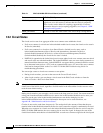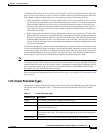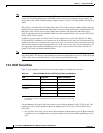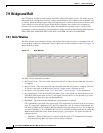
7-11
Cisco ONS 15310-MA SDH Reference Manual, Release 9.1 and Release 9.2
78-19417-01
Chapter 7 Circuits and Tunnels
Virtual Concatenated Circuits
Figure 7-2 Subnetwork Connection Protection Go-and-Return Routing
7.7 Virtual Concatenated Circuits
Virtual concatenated (VCAT) circuits, also called VCAT groups (VCGs), transport traffic using
noncontiguous TDM time slots, avoiding the bandwidth fragmentation problem that exists with
contiguous concatenated (CCAT) circuits. The ONS 15310-MA SDH cards that support VCAT circuits
are the CE-100T-8, CE-MR-6, and ML-100T-8 cards.
In a VCAT circuit, circuit bandwidth is divided into smaller circuits called VCAT members. The
individual members act as independent TDM circuits. All VCAT members should be the same size and
must originate/terminate at the same end points.
To enable end-to-end connectivity in a VCAT circuit that traverses through a third-party network, you
must create a server trail between the ports. For more details, refer to the “Create Circuits and VC
low-order path Tunnels” chapter in the Cisco ONS 15310-MA SDH Procedure Guide.
7.7.1 VCAT Circuit States
The state of a VCAT circuit is an aggregate of its member circuits. You can view whether a VCAT
member is In Group or Out of Group in the VCAT State column in the Edit Circuits window.
• If all member circuits are unlocked, the VCAT circuit is unlocked.
• If all In Group member circuits are locked, the VCAT circuit state is locked.
• If no member circuits exist or if all are Out of Group, the state of a VCAT circuit is locked.
Node B
Go and Return working connection
Go and Return protecting connection
Node A
96953
Any network Any network


















